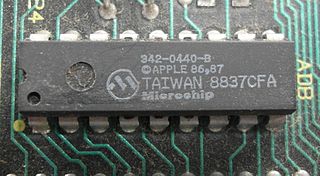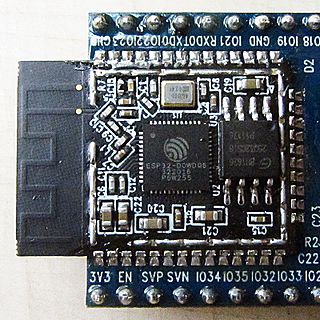
An integrated development environment (IDE) is a software application that provides comprehensive facilities to computer programmers for software development. An IDE normally consists of a source code editor, build automation tools, and a debugger. Most of the modern IDEs have intelligent code completion. Some IDEs, such as NetBeans and Eclipse, contain a compiler, interpreter, or both; others, such as SharpDevelop and Lazarus, do not. The boundary between an integrated development environment and other parts of the broader software development environment is not well-defined. Sometimes a version control system, or various tools to simplify the construction of a graphical user interface (GUI), are integrated. Many modern IDEs also have a class browser, an object browser, and a class hierarchy diagram, for use in object-oriented software development.

Zilog, Inc. is an American manufacturer of 8-bit and 16-bit microcontrollers. Its most famous product is the Z80 series of 8-bit microprocessors that were compatible with the Intel 8080 but significantly cheaper. The Z80 was widely used during the 1980s in many popular home computers such as the TRS-80 and the ZX Spectrum, as well as arcade games such as Pac-Man. The company also made 16- and 32-bit processors, but these did not see widespread use. From the 1990s, the company focused primarily on the microcontroller market.

A system on a chip or system on chip is an integrated circuit that integrates all components of a computer or other electronic system. These components typically include a central processing unit (CPU), memory, input/output ports and secondary storage – all on a single substrate. It may contain digital, analog, mixed-signal, and often radio frequency signal processing functions, depending on the application. As they are integrated on a single electronic substrate, SoCs consume much less power and take up much less area than multi-chip designs with equivalent functionality. Because of this, SoCs are very common in the mobile computing and edge computing markets. Systems on chip are commonly used in embedded systems and the Internet of Things.
Atmel Corporation was a designer and manufacturer of semiconductors before being acquired by Microchip Technology in 2016. It was founded in 1984. The company focuses on embedded systems built around microcontrollers. Its products include microcontrollers radio frequency (RF) devices including Wi-Fi, EEPROM, and flash memory devices, symmetric and asymmetric security chips, touch sensors and controllers, and application-specific products. Atmel supplies its devices as standard products, application-specific integrated circuits (ASICs), or application-specific standard product (ASSPs) depending on the requirements of its customers.
Adobe ColdFusion is a commercial rapid web application development platform created by J. J. Allaire in 1995. ColdFusion was originally designed to make it easier to connect simple HTML pages to a database. By version 2 (1996), it became a full platform that included an IDE in addition to a full scripting language.

Uniface is a development and deployment platform for enterprise applications that can run in a large range of runtime environments, including mobile, mainframe, web, Service-oriented architecture (SOA), Windows, Java EE and .NET. Uniface is a model-driven, Rapid Application Development (RAD) environment used to create mission-critical applications.
Maxim Integrated is an American, publicly traded company that designs, manufactures, and sells analog and mixed-signal integrated circuits.
Mobile app development is the act or process by which a mobile app is developed for mobile devices, such as personal digital assistants, enterprise digital assistants or mobile phones. These applications can be pre-installed on phones during manufacturing platforms, or delivered as web applications using server-side or client-side processing to provide an "application-like" experience within a Web browser. Application software developers also must consider a long array of screen sizes, hardware specifications, and configurations because of intense competition in mobile software and changes within each of the platforms. Mobile app development has been steadily growing, in revenues and jobs created. A 2013 analyst report estimates there are 529,000 direct app economy jobs within the EU 28 members, 60% of which are mobile app developers.

Microchip Technology Inc. is an American publicly-listed corporation that is a manufacturer of microcontroller, mixed-signal, analog and Flash-IP integrated circuits. Its products include microcontrollers, Serial EEPROM devices, Serial SRAM devices, embedded security devices, radio frequency (RF) devices, thermal, power and battery management analog devices, as well as linear, interface and wireless solutions. Examples of these solutions include USB, zigbee, MiWi, LoRa, SIGFOX and Ethernet.
Parallax SX is a discontinued line of microcontrollers that was marketed by Parallax, from a design by Ubicom. Designed to be architecturally similar to the PIC microcontrollers used in the original versions of the BASIC Stamp, SX microcontrollers replaced the PIC in several subsequent versions of that product.
The DS80C390 is a microcontroller whose architecture is derived from that of the Intel 8051 processor series, introduced by Dallas Semiconductor. It features an increased code memory address space of twenty-two bits, as opposed to the sixteen bit space of the original 8051 processor. It also includes two Controller Area Network (CAN) controllers and a 32-bit integer coprocessor. The open-source Small Device C Compiler (SDCC) supports the processor. It was used in the initial version of the Tiny Internet Interface (TINI) processor module where it was superseded by the DS80C400, a processor that also incorporates an Ethernet port.
Openbravo is a cloud-based software provider specialized in retail solutions. The head office of Openbravo S.L. is located in Pamplona, Spain. Openbravo also has offices in Barcelona, Paris, Mexico DF and Kolkata. The company's main product is Openbravo Commerce Cloud, a cloud-based POS and Retail Management solution. For the worldwide distribution and implementations of its software, Openbravo relies heavily on its partner network. Openbravo is a multiple-time winner of Infoworld's Bossie award for best open source software application, last awarded in August 2014.
The i.MX range is a family of Freescale Semiconductor proprietary microcontrollers for multimedia applications based on the ARM architecture and focused on low-power consumption. The i.MX application processors are SoCs (System-on-Chip), that integrate many processing units into one die, like the main CPU, a video processing unit and a graphics processing unit for instance. The i.MX products are qualified for automotive, industrial and consumer markets. Most of them are guaranteed for a production lifetime of 10 to 15 years.
Many devices use i.MX processors, such as Ford Sync, Kobo eReader, Amazon Kindle, Zune, Sony Reader, Onyx Boox readers/tablets, SolidRun SOM's, some Logitech Harmony remote controls and Squeezebox radio, some Toshiba Gigabeat mp4 players. The i.MX range was previously known as the "DragonBall MX" family, the fifth generation of DragonBall microcontrollers. i.MX originally stood for "innovative Multimedia eXtension".

ioBridge is a manufacturer of Internet-based monitor and control hardware and a provider of seamlessly integrated cloud-based social Web 2.0 folksonomies and curated online API webservices, using WebSocket, JSON and a host of other related technologies.
Mbed is a platform and operating system for internet-connected devices based on 32-bit ARM Cortex-M microcontrollers. Such devices are also known as Internet of Things devices. The project is collaboratively developed by Arm and its technology partners.
UDOO is a single-board computer with an integrated Arduino Due compatible microcontroller, designed for computer science education, the world of Makers and the Internet of Things.

MicroPython is a software implementation of the Python 3 programming language, written in C, that is optimized to run on a microcontroller. MicroPython is a full Python compiler and runtime that runs on the micro-controller hardware. The user is presented with an interactive prompt to execute supported commands immediately. Included are a selection of core Python libraries; MicroPython includes modules which give the programmer access to low-level hardware.

ESP32 is a series of low-cost, low-power system on a chip microcontrollers with integrated Wi-Fi and dual-mode Bluetooth. The ESP32 series employs a Tensilica Xtensa LX6 microprocessor in both dual-core and single-core variations and includes in-built antenna switches, RF balun, power amplifier, low-noise receive amplifier, filters, and power-management modules. ESP32 is created and developed by Espressif Systems, a Shanghai-based Chinese company, and is manufactured by TSMC using their 40 nm process. It is a successor to the ESP8266 microcontroller.








